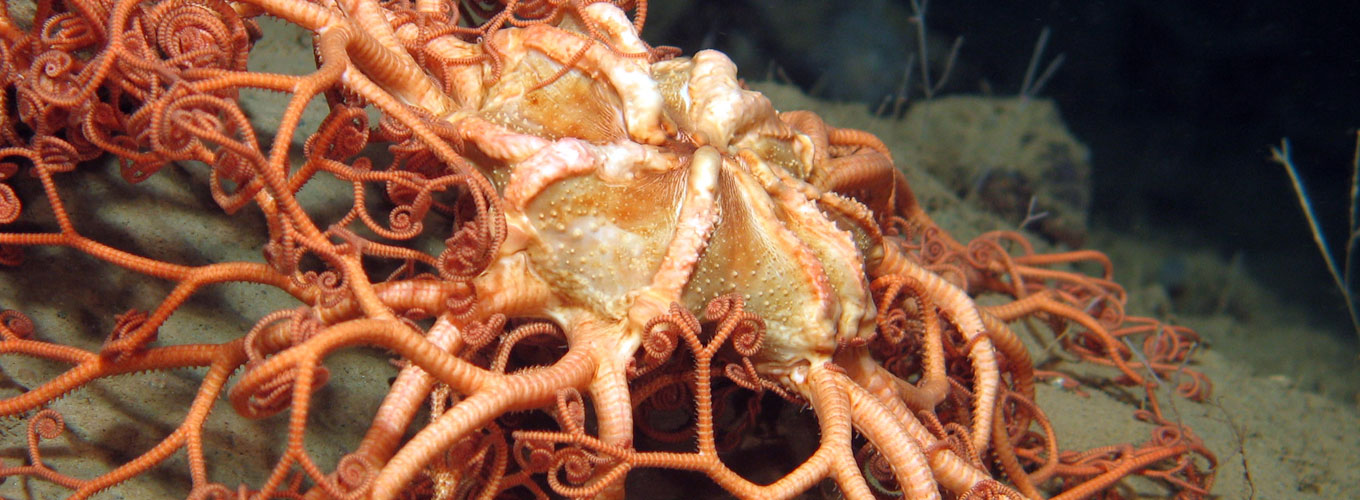Impact: New species discovery, novel medicinal chemical products, improved deep sea exploration technology, museum exhibitions, industry-research coordination and collaboration
A partnership between university researchers and the oil and gas industry is radically expanding our knowledge of life on the floor of the deep sea.
With a UOW team leading the chemistry section, the collaboration is influencing how we understand, explore, exploit and manage the deep sea floor in areas including habitat mapping, biodiversity, medicinal chemistry, natural resources and governance.
Vast oceans cover 70 per cent of the world’s surface and 95 per cent of this ocean is over 100 metres deep. Yet less than five per cent of the deep-sea floor has been explored - we know more about the moon’s surface than we do about the deep-sea floor and the potentially millions of species that inhabit it.
The logistical difficulty and prohibitive expense of conducting deep-sea research has hindered academic research in this area.
However, there are a number of industries operating in the deep-sea utilising specialist robotics called remotely operated vehicles (ROVs), controlled at the surface to operate under water to depths of 3500 metres. ROVs are an integral component of any operation occurring on the deep-sea floor and are widely used by the oil and gas industry in both exploration and production.
UOW’s Dr Danielle Skropeta and a cross-disciplinary, collaborative team have established partnerships with the Australian oil and gas industry to utilise their ROVs in periods of stand-by time, providing the researchers with unprecedented access to the deep-sea floor for fundamental studies in areas including oceanography, marine biology and ecology, and natural products chemistry.
The collaboration has yielded results, including seminal reviews of natural chemicals produced by deep-sea organisms for chemical defence and communication, published in leading journals.
This original research has contributed to an emerging trend in medicinal chemistry, showing deep-sea natural products to have an incredibly high ‘hit’ rate, in particular against cancer. This means that the percentage of natural chemicals exhibiting anticancer activity discovered in deep-sea samples, in some cases as high as 50-75 per cent of samples assessed, far exceeds that typically seen in natural product-based drug discovery.
The partnership has also seen new species and genus of marine life uncovered, the development of more sensitive and higher resolution 3D underwater cameras, and the design of museum exhibits on the deep-sea.
It has informed the development and direction of policies and regulations governing partnerships centred on deep-sea biodiversity and equitable benefit sharing from exploration of a natural resource.
Crucially, the emphasis on partnership has seen important questions about the impacts, both positive and negative, of drilling operations addressed, while strengthening academic and industry relations and providing students with first-hand experiences of working in an offshore environment.
* Image credit: The basket star Gorgonocephalus caputmedusae at 920m depth. Midnattsol, Norway. Image courtesy of SERPENT Project, National Oceanography Centre, UK
- UOW
Dr Danielle Skropeta
Professor Andy Davis
Allison Broad
Dr Ana Zivanovic
Dr Liangqian Wei - UNIVERSITY OF TECHNOLOGY, SYDNEY
Professor David Booth
Dr Ash Fowler
Dr Peter McCreadie
Vanessa Valenzuela-Davie
Nico Pradella - UNIVERSITY OF WESTERN AUSTRALIA
Professor Chari Pattiaratchi - UNIVERSITY OF SYDNEY
Professor Stefan Williams
Dr Will Figueira - AUSTRALIAN MUSEUM
- WA MUSEUMS
- NATIONAL OCEANOGRAPHIC CENTRE SOUTHHAMPTON
- WOODSIDE
- SANTOS
- CHEVRON
- ENI
- APACHE
- INPEX
- OCEANEERING
- SUBSEA 7
Copyright © 2014 University of Wollongong. CRICOS Provider No: 00102E Privacy | Disclaimer & Copyright Info | Site Map

